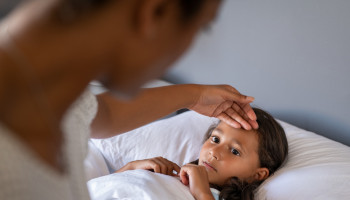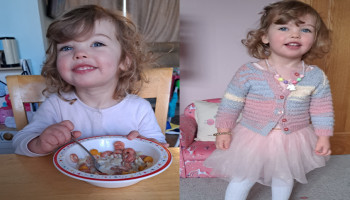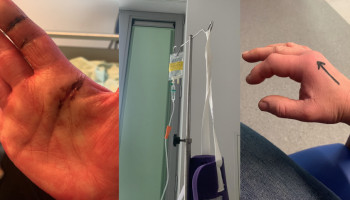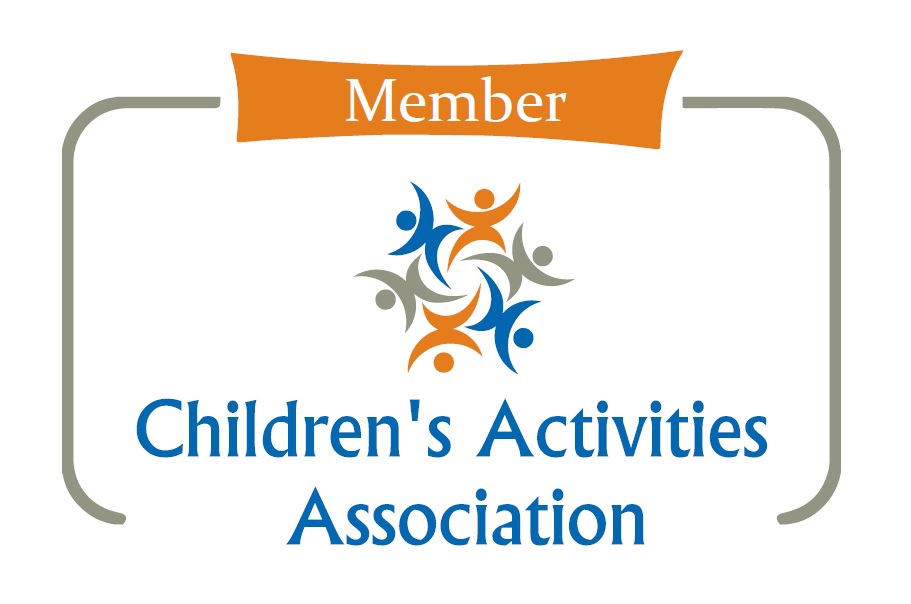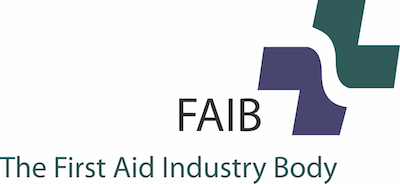This week we hear from Caroline, whose 3 week old son Alfie almost died after contracting meningitis and sepsis. Every parent should know about these life-threatening illnesses, but in a recent survey, 6 in 10 parents said they wouldn’t recognise the signs. At Mini First Aid, we want to make sure every one of you reading this has the knowledge needed to save your child’s life if they develop meningitis and/or sepsis, and we’d like to thank Caroline for bravely sharing little Alfie’s story with us.
Hi Caroline, can you tell us a little bit more about you and your family?
Of course - I am a 29-year-old primary teacher from Scotland and live with my husband, Chris and our two sons, Arthur (aged 3) and Alfie (now 18 months).
Can you describe what happened the day Alfie got poorly?
Alfie was just three weeks old when he got ill. It had been a normal day, we had visited my sister and her husband and I had enjoyed time with my older son Arthur while they cuddled Alfie – something I was making a conscious effort to do now there was a new baby on the scene! I do remember my brother-in-law asking if it was normal for Alfie to sleep as long as he was because it was pushing four hours. It was the longest he had slept for but I wasn't worried. He woke and fed normally and we went home and continued with our day as normal.
What happened at bedtime Caroline?
I put my older son to bed while Chris cuddled Alfie downstairs. I then fed Alfie and went to bed myself – those newborn days are exhausting! Chris then went to work as he was on a nightshift, so I breastfed Alfie in our bed and ended up falling asleep with him. I woke up an hour or so later because of the heat of Alfie against my arm. He was really hot, hotter than either of my boys had ever felt. I thought he may have overheated somehow, but he didn’t have a blanket or duvet on him, just a fleecy sleepsuit, so I began to quickly undress him.
What other symptoms was Alfie showing at this point Caroline?
He was not crying. When I took off his clothes I noticed his ribs and neck sucking in as he was breathing. Looking back at the videos I sent my husband at work, Alfie’s skin was pale and mottled but I did not notice this in the low light at the time. Alfie’s breathing was rapid and he then started making grunting noises – I was unfortunately not aware these were signs of sepsis at the time.
The grunting noise must have been so frightening – what did you do?
After looking on NHS Inform I phoned 111 for advice and the call handler was amazing. She was going through the questions then heard Alfie’s grunting and her tone changed. She said in a very concerned voice, “is that your baby? Is that normal for him?” I burst into tears because I could tell by her tone it was serious. She said the ambulance was on its way and I needed to tell my husband to come home now to be there for Arthur when we left in the ambulance.
That wait for the ambulance must have been awful . . .
I didn't know what to do in that moment so just paced the house with Alfie, waiting for the ambulance – I didn't pack a bag, get either of us a change of clothes, grab nappies, nothing. I was in shock and had no idea what to do so I just paced the house holding Alfie.
When the ambulance arrived, the crew got me to lie on the bed in the ambulance and put Alfie on my chest to try and regulate his temperature. He was in a nappy with a small blanket over the two of us and the only things I took with me (stupidly!) was the baby grow he had been wearing and my phone.
It's not stupid at all Caroline, shock is real and none of us know how we will react in those circumstances. Can you tell us what happened when you got to hospital with Alfie?
When we got to hospital, Alfie’s sepsis symptoms had strangely settled down and the nurse was saying things like, “have you given Mummy a fright tonight!” Then a paediatric doctor – who just happened to pop in because he saw such a young baby in A&E – asked to see the videos I had sent Chris. Everything changed from there.
I did not know in that moment but they strongly suspected Alfie had sepsis from the videos and ran blood tests. They then re-ran the tests - his numbers were so bad they thought there must have been an error but, unfortunately, there was not.
That night we were told we would be transferred to another hospital - we knew Alfie had sepsis but did not know where the infection was coming from. The decision was made that Edinburgh would be best for Alfie as there were concerns he had a gastrointestinal issue due to his abdomen becoming so distended - you could actually see his veins through his stretched skin. Alfie was airlifted by a neonatal transfer team from Aberdeen to a paediatric critical care unit in Edinburgh while myself and Chris drove the 3.5 hours – a drive I never want any other parent to have to repeat. The fear we felt on that journey, being separated from Alfie whilst he was fighting for his life was horrendous.
When did you find out it was meningitis that had caused Alfie’s sepsis Caroline?
At this point we still didn't know that Alfie had meningitis but we were beginning to rule things out and his infections markers were decreasing, showing he was on the correct antibiotics.
We found out later that Alfie had E-Coli meningitis that was caused by an infection that originated in his bladder/ureters and was confirmed by a lumbar puncture – this failed 4 times, hence the delay in diagnosis. I was aware while in Edinburgh that having sepsis and meningitis potentially had permanent, life-changing implications for Alfie. Alfie was in hospital in Edinburgh for 2 weeks, with a further 2 weeks of daily hospital visits for checks and IVs back at our local hospital.

Considering everything you went through, what are the key things other parents can learn from Alfie’s experience?
At no point did Alfie develop a rash from either the sepsis or the meningitis. Before Alfie got sick, I thought meningitis always came with the rash everyone talks about. It doesn’t.
I, like many parents unfortunately, had limited knowledge about the signs of sepsis and meningitis. I knew about the stiff neck, light sensitivity and non-fading rash with meningitis but the first two are so difficult to know for sure with young babies. Alfie did not have the typical rash so meningitis was not at the forefront of my mind.
I was aware of how serious and life-threatening sepsis was from watching programs like ‘999, What’s Your Emergency’ and ’24 Hours in A&E’. Looking back at the videos with the knowledge I have now, Alfie was a classic sepsis case but I wasn’t aware of that. Luckily, I acted quickly and the outcome was positive but speed is absolutely essential, so understanding meningitis and sepsis and spotting the signs is crucial.
Caroline’s quick action saved little Alfie’s life that night. Vinnie Smith, CEO of the Meningitis Research Foundation says:
“Meningitis is feared, and with good reason . . . time is of the essence when treating meningitis. With NHS emergency units under pressure, it’s vital that health professionals spot the signs of meningitis quickly. Sadly, we know of many families who have lost loved ones within hours.”
Symptoms of meningitis in babies and children:
- Tense or bulging soft spot (fontanelle on head)
- A high temperature above 38 degrees (but be aware that temperature could be normal or even low in babies under 3 months)
- Headache
- Very sleepy, or too sleepy to wake up
- Fast breathing, or difficulty breathing
- Extreme shivering
- Cold hands and feet
- Vomiting or refusing to feed
- Pain and / or irritability from muscle aches or severe limb / joint pain
- Stiff or rigid neck
- Dislike of light
- “Pin prick” rash or purple bruises anywhere on the body (not always present and can be difficult to spot on black and brown skin)
- Blotchy skin, getting paler or turning blue on white skin, ashy or grey appearance on black and brown skin. Also look for pale eyelids, inside of mouth
Please be aware that the more well-known symptoms such as stiff neck, aversion to bright lights, and the non-blanching rash (does not disappear under pressure), can often appear later on or not at all.
Symptoms of sepsis
The most common symptoms in children are:
- Very fast breathing
- Grunting noise
- Seizure or a ‘fit’
- Skin that's mottled, pale or slightly blue on white skin, ashy or grey on black and brown skin
- Rash that does not fade when you press it
- Very lethargic or difficult to wake
- Abnormally cold to touch
The most common symptoms of sepsis in children under 5 are as above, and also include:
- Not feeding
- Vomiting repeatedly
- Not passing urine for 12 hours
As you can see, many of these symptoms overlap with each other but also with less serious childhood illnesses.
If you even suspect either meningitis or sepsis, seek immediate medical help and always ask “Could it be meningitis / sepsis?”
At Mini First
Aid, we work closely with the Meningitis Research Foundation and The Sepsis
Trust, making sure our first aid trainers have the most up to date, in depth
knowledge possible. You can learn how to spot the signs of meningitis and
sepsis at our 2 hour Baby and Child class
Thank you so much to Caroline and her family for sharing Alfie’s story.
Stay safe everyone, Mini First Aid x
Sources: Meningitis Research Foundation, The Sepsis Trust, First Aid Voices
A family essential
 We love our large Family First Aid Kit, voted Best Buy at the Loved By Parents Awards. An essential for all families, keep one at home and one in your car. Our attractive kit bag contains:
We love our large Family First Aid Kit, voted Best Buy at the Loved By Parents Awards. An essential for all families, keep one at home and one in your car. Our attractive kit bag contains:
- a digital thermometer to quickly and accurately check temperature
- an instant ice pack to cool and soothe
- non-alcohol wipes to keep wounds clean and infection free
- an assortment of plasters to help keep wounds free from infection
- bravery stickers for your poorly soldiers
- and loads more first aid essentials including tweezers, bandages, burn gel and foil blankets

